Virtual reality offers disabled yoga lovers unprecedented accessibility by eliminating travel barriers and adapting to your specific mobility needs. You’ll practice in the privacy of your home with personalized difficulty settings and real-time form guidance. VR yoga helps manage chronic pain, builds global communities regardless of physical limitations, and transforms rehabilitation into an engaging experience. The immersive environments reduce anxiety while improving balance and mobility—discover how this technology is revolutionizing inclusive wellness practices worldwide.
Why Disabled Yoga Lovers Need Virtual Reality
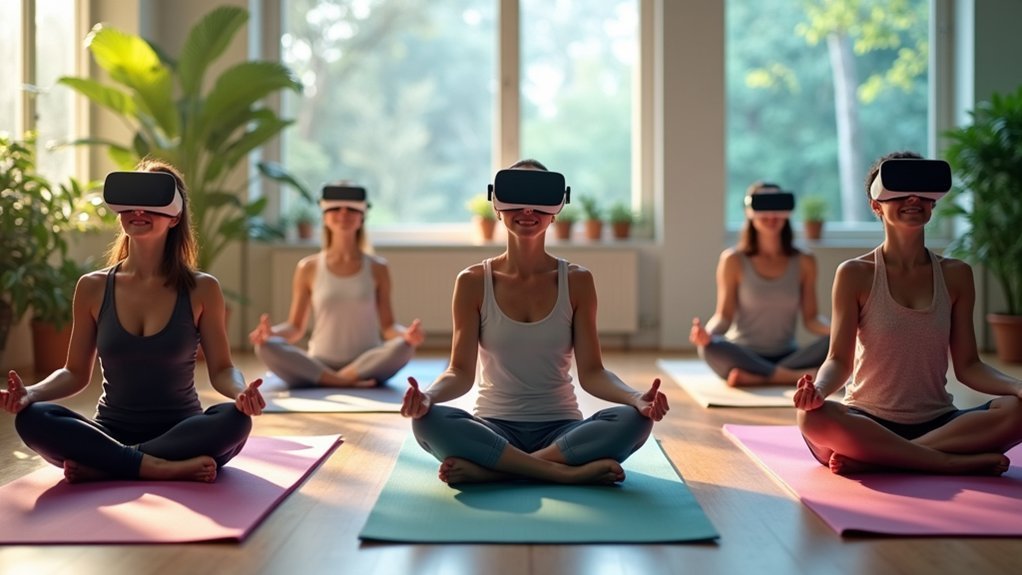
While conventional yoga studios often present physical and psychological barriers, virtual reality offers unprecedented access to the benefits of yoga for those with disabilities.
You’ll find that VR eliminates the need to travel to studios, removing a significant hurdle that might’ve prevented your participation.
In virtual environments, you can practice modified poses that accommodate your specific limitations.
The privacy of VR practice also reduces the intimidation you might feel in group settings where others can observe your movements.
VR yoga provides consistent access regardless of weather, transportation issues, or facility accessibility problems. Real-time feedback systems in VR yoga applications help practitioners track their progress and encourage continued effort and engagement.
Practice yoga on your terms—anytime, anywhere—without battling weather, seeking rides, or navigating inaccessible facilities.
You’ll appreciate the ability to tailor your experience with customizable environments and difficulty levels.
This personalization, combined with real-time feedback on your form, creates an ideal practice space that traditional studios simply can’t match.
Breaking Physical Barriers: How VR Removes Studio Access Challenges
Virtual reality brings the yoga studio directly to your home, eliminating the need to navigate inaccessible physical spaces.
You won’t have to worry about transportation challenges, weather conditions, or buildings without proper ramps and accommodations.
VR technology transforms any room into your personal yoga sanctuary, where mobility limitations no longer prevent you from experiencing the full benefits of a structured practice. The metaverse environment offers unprecedented opportunities for remote engagement without geographic constraints, making yoga more accessible to those with disabilities.
Home-based Yoga Revolution
For millions of disabled individuals, accessibility barriers have long prevented participation in traditional yoga studios, creating a sense of exclusion from this beneficial practice.
Virtual reality is changing this reality by bringing yoga directly to your home. You’ll no longer need to worry about transportation challenges or inaccessible studio spaces.
VR yoga considerably reduces costs compared to private instructors or studio memberships, making wellness more financially accessible.
In your VR practice space, you can engage without feeling self-conscious or judged. The technology adapts to your specific mobility needs and abilities, offering personalized guidance that traditional settings often can’t provide. Studies show that participants reported excellent compliance with VR-delivered interventions, making this particularly promising for those with mobility limitations.
This revolution doesn’t just remove physical barriers—it creates an entirely new approach to yoga that puts you in control of your practice.
Mobility Hurdles Disappear
Traditional yoga studios present formidable obstacles for those with mobility challenges, but VR technology is completely transforming this landscape.
You’re no longer bound by physical limitations or geographical constraints when practicing yoga. Virtual environments eliminate transportation hurdles, architectural barriers, and scheduling conflicts that previously prevented full participation. Virtual Reality yoga offers immersive environments that can transport practitioners to serene natural settings for enhanced practice.
VR platforms deliver three critical advantages:
- Financial freedom – You’ll spend considerably less on equipment than years of studio memberships
- Personalized practice – Your virtual experience adapts to your specific mobility needs, unlike rigid studio formats
- Community connection – You’ll join fellow practitioners worldwide, ending isolation often experienced by those with disabilities
This technological evolution democratizes yoga practice, ensuring everyone can access its benefits regardless of physical limitations or location.
Customized Practice: Tailoring Virtual Yoga Environments to Your Disability

You’ll find VR yoga environments offer boundless virtual space that can accommodate your specific mobility needs without the constraints of physical studios.
These digital platforms feature adjustable difficulty settings that let you customize your practice based on your disability, whether you need modified poses or specialized movement options.
With your personalized virtual environment, you’re free to progress at your own pace while still experiencing the full benefits of yoga practice.
Space Without Limitations
While physical yoga studios often present numerous barriers for disabled practitioners, virtual reality environments open up boundless possibilities for accessible practice.
You’ll experience customized settings that adapt to your specific needs, with sensory integration options that create the perfect atmosphere for your practice.
VR removes traditional constraints by offering:
- Complete control over your environment – adjust lighting, sound, and visual stimuli to prevent sensory overload
- Freedom to move in ways that might be impossible in physical spaces – explore poses without physical barriers
- Personalized assistance that evolves with your practice – receive adaptive guidance that responds to your unique movements
You’ll gain confidence as virtual environments transform to accommodate your specific disability, creating a truly inclusive yoga experience. The psychological satisfaction experienced during virtual yoga can significantly help reduce pain levels in conditions like chronic low back pain.
Adjustable Difficulty Settings
As your abilities and needs shift from day to day, VR yoga platforms provide adjustable difficulty settings that respond intuitively to your unique circumstances.
These systems monitor your performance and automatically modify intensity levels, guaranteeing you’re always appropriately challenged without risking injury.
You’ll appreciate how VR yoga adapts to your energy levels and emotional state.
Feeling fatigued? The program will suggest gentler sequences.
Experiencing a high-energy day? Your virtual instructor can increase complexity accordingly.
This real-time responsiveness means you’re never stuck with preset routines that ignore your body’s current capabilities.
The technology’s motion tracking capabilities deliver precise feedback on your form, offering alternatives when certain poses aren’t accessible.
This personalized approach guarantees you’ll always find a meaningful practice that respects your boundaries while encouraging growth.
Recent research from the University of Bath demonstrates that VR exergames can detect and respond to your emotional state through physiological changes measured by sensors in the headset and wearables.
The Pain Management Revolution: VR Yoga’s Impact on Chronic Conditions
Virtual reality has emerged as a groundbreaking solution in pain management, offering disabled yoga enthusiasts a non-pharmacological alternative to traditional treatments.
Studies show VR yoga markedly reduces pain intensity by immersing you in calming environments that distract from discomfort while promoting relaxation.
Immersive VR yoga environments create a powerful pain-relief pathway by redirecting focus from discomfort to serenity.
Unlike potentially addictive medications, VR yoga combines physical benefits with mental peace in a completely safe format.
Research comparing VR to traditional relaxation techniques consistently reports impressive reductions in pain scores through:
- Immersive distraction that literally takes your mind off pain
- Personalized experiences tailored to your specific mobility challenges
- Decreased physical stress evidenced by lowered heart rates during sessions
You’ll gain access to therapeutic yoga benefits without leaving home, potentially reducing your dependence on pain medications while improving overall functionality. Recent research conducted at Cedars-Sinai Medical Center demonstrated significant pain reduction in hospitalized patients using VR for just ten minutes three times daily.
Building Community Without Leaving Home: Social Connection in Virtual Studios
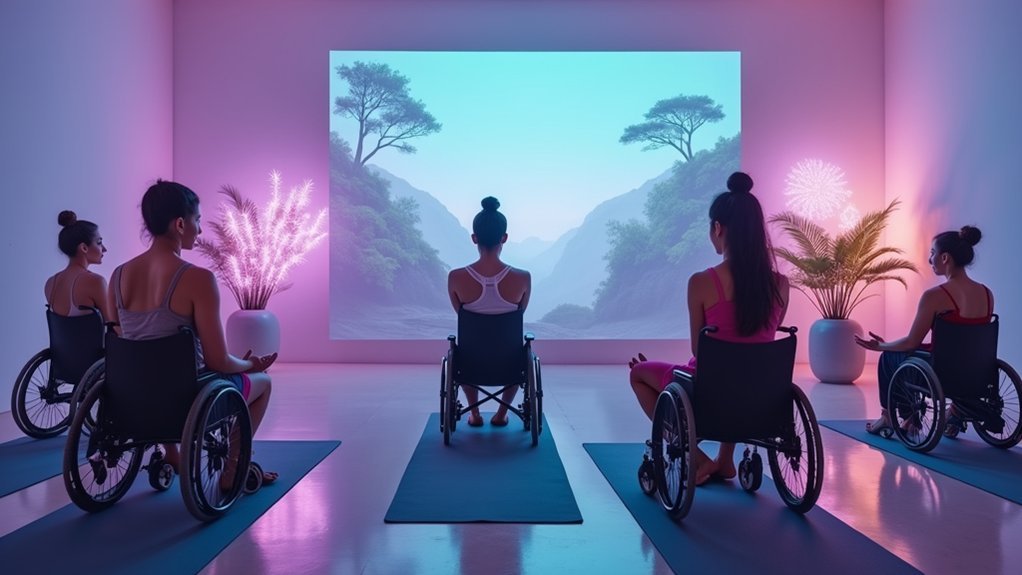
Isolation often accompanies disability, but adaptive VR yoga studios are shattering this barrier through innovative social connections.
You’ll find these virtual spaces create genuine community without transportation worries or accessibility challenges.
Virtual yoga sessions offer you safety and comfort while connecting with others who share similar experiences.
If you struggle with social anxiety or mobility limitations, you can now participate fully from your home environment.
The global reach of these platforms means you’re no longer limited by geography—connect with fellow practitioners worldwide.
Many platforms include accessibility features like audio descriptions for visually impaired users, ensuring everyone can participate.
As the market expands toward $11.10 billion by 2030, you’ll continue to see improvements in technology that further enhance your social experience and sense of belonging.
These platforms increasingly incorporate augmented reality and AI to personalize your practice and make connections more meaningful across diverse ability levels.
Mental Wellness Benefits: Anxiety and Depression Reduction Through Virtual Practice
While traditional mental health interventions often require in-person appointments, VR yoga offers powerful anxiety and depression reduction benefits from the comfort of your home.
Studies show immersive VR meditation greatly reduces anxiety symptoms and depressive states while improving emotional regulation.
You’ll experience:
- Immediate physiological relief – decreased heart rate and worry through immersive environments that engage your mind more effectively than traditional meditation.
- Enhanced emotional control – better management of difficult emotions like anger and sadness, improving your overall quality of life.
- Long-lasting mental wellness – sustained positive mood effects that protect against anxiety disorders and reduce depression severity without medication. This approach is especially valuable considering the WHO estimates 970 million adults worldwide experience mental health challenges.
This drug-free intervention offers comparable or superior results to conventional meditation, making it invaluable for disabled practitioners seeking accessible mental health support.
Rehabilitation Reimagined: Using VR Yoga for Recovery and Mobility Improvement
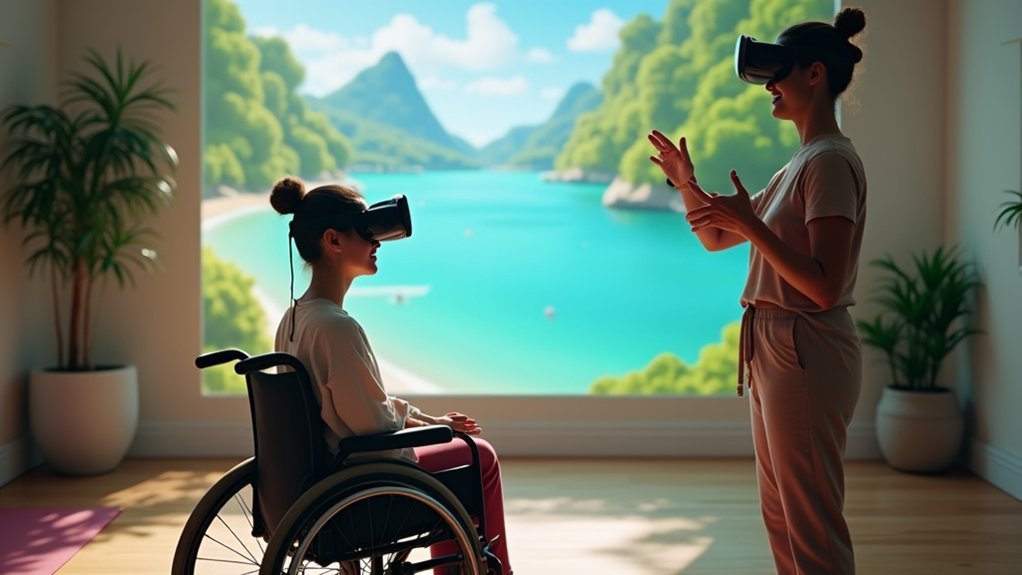
Beyond traditional physical therapy’s repetitive exercises, VR yoga transforms rehabilitation into an engaging journey that accelerates recovery and improves mobility for disabled practitioners.
You’ll experience personalized sessions that adapt in real-time to your progress, preventing overexertion while optimizing your improvement.
In VR’s safe environment, you can practice movements without fear of falling or injury, building confidence that translates to real-world mobility. The controlled environment eliminates risks associated with severe injuries while allowing gradual functional recovery.
Studies show impressive results: 17% decreases in disability scores and nearly 30% improvement in balance after VR yoga interventions.
For chronic pain management, VR’s immersive distraction increases your pain tolerance while making therapy enjoyable.
This enjoyment matters—you’re more likely to stick with rehabilitation programs when they’re engaging, reducing dropout rates and supporting your long-term recovery journey.
The Technology Gap: Making VR Yoga Accessible and Affordable
The promising benefits of VR yoga for rehabilitation face a significant roadblock: technology access. If you’re disabled and living on a fixed income, the combined costs of headsets, controllers, software, and reliable internet can put virtual yoga studios out of reach.
Current VR yoga apps often fail to accommodate your specific needs, lacking customizable interfaces for various physical limitations or compatibility with assistive devices you rely on. Research published in Frontiers in Psychology demonstrates the effectiveness of VR in enhancing mindfulness practices for various demographics.
To bridge this divide, we need:
- Affordable hardware options specifically designed for accessibility needs
- Universal design principles incorporated into all VR yoga applications
- Financial assistance programs or insurance coverage for therapeutic VR technologies
Without addressing these barriers, VR yoga’s transformative potential remains inaccessible to those who might benefit most.
Real-Time Guidance: How Virtual Coaches Enhance Proper Form and Safety
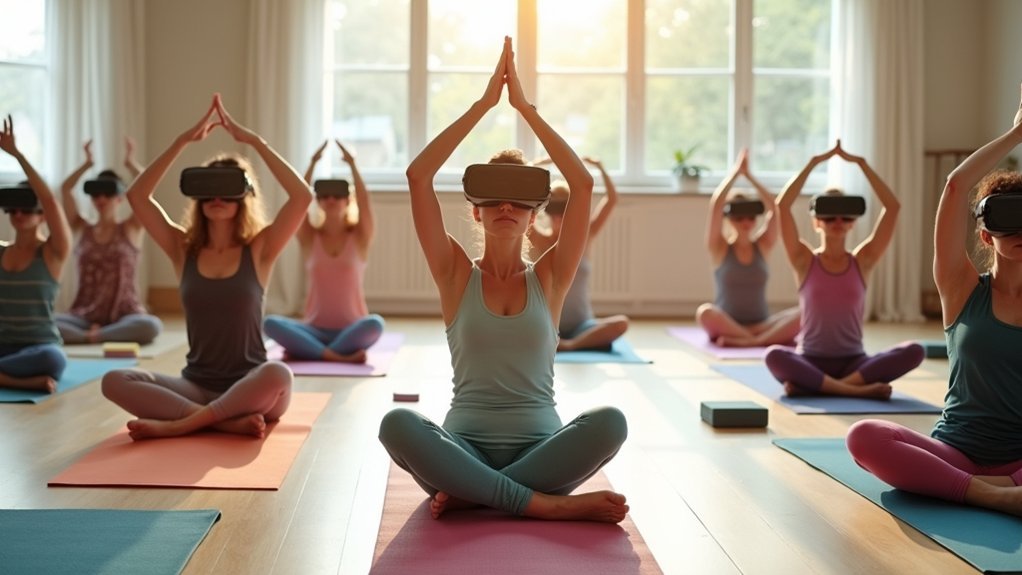
For disabled yoga practitioners, virtual coaches in VR environments offer unprecedented guidance you’d never receive in traditional settings.
These systems provide immediate feedback on your form while adapting to your specific mobility challenges. Virtual instructors analyze your movements through AI technology, offering precise anatomical corrections that prevent injury.
You’ll receive personalized suggestions based on your unique body limitations, with real-time adjustments that make poses safer and more effective. The technology integrates wearables that monitor your physical responses, alerting you to potential strain before injury occurs.
For practitioners with disabilities, this means practicing confidently with modified poses tailored to your abilities. The continuous feedback loop guarantees you’re constantly improving while maintaining proper alignment—something particularly vital when maneuvering yoga with physical limitations. Recent studies have shown that VR-based training can lead to significant improvements in functional fitness for older adults with limited mobility.
Frequently Asked Questions
Can VR Yoga Be Effective for People With Visual Impairments?
Yes, VR yoga can be highly effective for you if you’re visually impaired. You’ll benefit from vibrotactile feedback, depth camera technology, and personalized guidance that helps you correctly align poses without visual cues.
How Does VR Yoga Compare to In-Person Adaptive Yoga Classes?
VR yoga offers you flexibility, privacy, and convenience that in-person adaptive classes can’t match. You’ll enjoy personalized modifications, consistent availability, and reduced travel barriers, though you’ll miss hands-on adjustments and direct community interaction.
What Motion Tracking Equipment Works Best for Wheelchair Users?
For wheelchair users, the ALL Wheelchair AI Motion Tracking System works best with its IMU sensors for thorough movement tracking. You’ll benefit from its fall detection, essential sign monitoring, and gaming integration for engagement.
Are There VR Yoga Programs Specifically Designed for Specific Disabilities?
Yes, you’ll find VR yoga programs specifically designed for autism, stroke recovery, cerebral palsy, and motor skills disorders. They offer personalized approaches with features tailored to each disability’s unique needs and capabilities.
Can Caregivers Participate Alongside Disabled Practitioners in VR Yoga?
Yes, you can participate alongside your disabled loved ones in VR yoga. You’ll both wear headsets, follow the same instructor, and share the experience, strengthening your bond while providing valuable support during practice.
In Summary
VR yoga isn’t just a tech novelty—it’s your gateway to a practice that accommodates your unique needs. You’ll find freedom from physical barriers, personalized approaches to your disability, and a supportive community at your fingertips. As technology becomes more accessible, you’re looking at a future where your yoga journey continues unhindered, guided by expert instruction that adapts to you. Don’t wait—your mat in virtual space is ready.

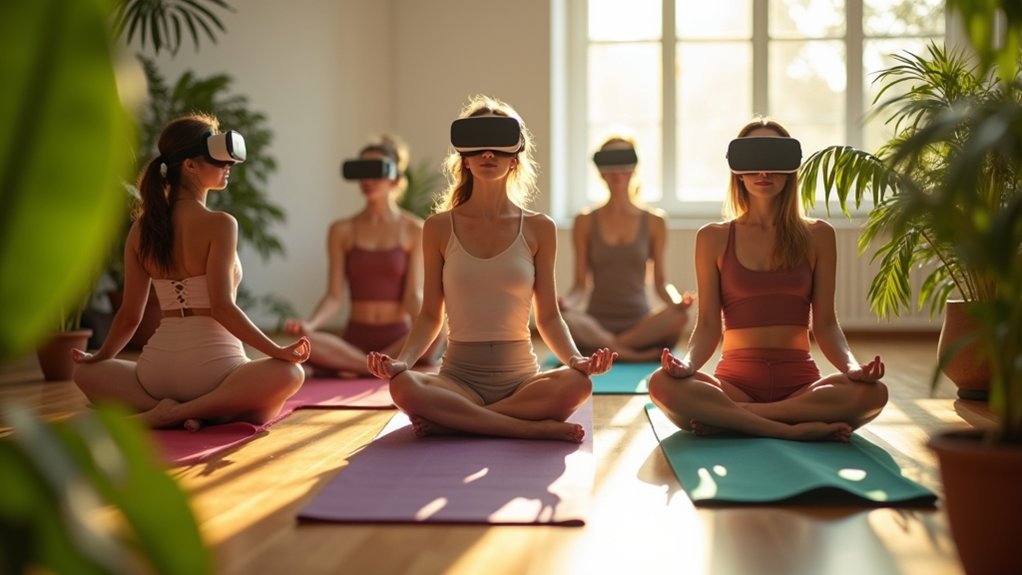



Leave a Reply